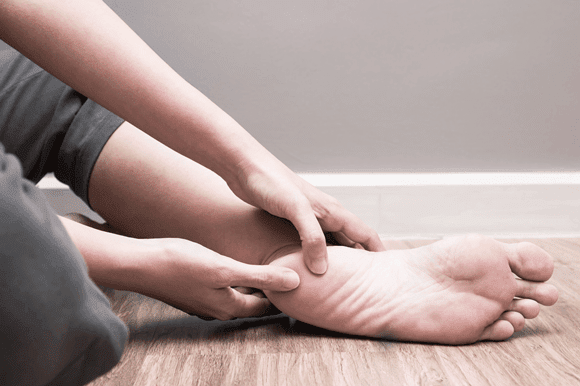
Out of the 33 joints, over 100 tendons, and 26 bones that make up your foot and ankle, your heel is one of the largest. Not only because of its size, but there are also a few reasons why the Achilles heel might literally be your Achilles heel. The heel takes a major beating since it bears a lot of weight. The weight-bearing aspect can lead to a cause in heel pain, which can feel minor to even disabling. An educated diagnosis from a podiatrist can help not only source the reason for your pain but put you on a treatment plan to help ease it.
In this article, we’re going to go through the potential and common causes of heel pain to the ways you can treat it. The calcaneus, or the heel bone, which is located right beneath your ankle, is surrounded by tissue and the talus. The heel bone is responsible for helping you find your balance while you move.
The Common Causes of Heel Pain
To help find your diagnosis, it’s best to find the roots of common causes of heel pain. Although there are many of them, here are the top four causes for heel pain:
Plantar Fasciitis: Known to show up in those who are on their feet all too often, for long hours of the day, Plantar Fasciitis will occur when there is a lot of pressure in your feet. All this pressure can affect your ligament, pain, and stiffness in your heel.
As one of the most common causes of heel pain, the source of the pain can be run back to a thick band of tissue that is located across the bottom of your foot. Once this tissue is inflamed, it can lead to a feeling of pain in other areas as well since it connects your toes directly to your heel bone, covering major spots along the bottom of your feet.
This stabbing pain will show up normally right in the morning or the beginning of your day. With movement, the pain tends to decrease but can come back if you have been sitting or standing for a long time.
Fracture: Whether it is a hairline fracture of the heel bone or a full on the broken bone, you might be feeling extreme pain in your heel area. If you have suffered pain by cause of an impacting injury, it could be a fracture. If you think you might have a fracture, you will need to head to urgent care. A fracture in the heel is deemed as a medical emergency and should be taken seriously.
Most of these fractures, located in the calcanea area of your body are generally from a traumatic event. Whether it is a falling or motorcycle accident, this type of injury is also seen going hand in hand with an ankle sprain or other sorts of injuries.
You can also have a stress fracture, which are caused by repetitive stress on the heel bone, which leads to overuse and pain.
There are also fractures that involve the joint, which need serious medical care, as soon as possible. Those without the joint are avulsion fractures, which normally occur after fracturing multiple fragments of your bone. Stress fractures are also avulsion fractures.
Strains and Sprains: Other injuries to the heel that can occur because of physical activity are strains and sprains. The injury, whether it is a sprain or a strain, can be from a small degree to extremely severe.
To know the difference between a sprain and a strain, one symptom often gives them the identity of the injury away. Although most of the symptoms of both injuries are the same—pain around the joint, swelling, and limited flexibility, sprains will cause bruising to occur while strains will not. Strains normally cause muscle spasm symptoms.
Achilles Tendonitis: This injury occurs directly to the Achilles (as the part of the body is in the name). This tendon, anatomically speaking, goes from the foot and attaches directly to the calf muscles. It can become painful and inflamed—thus creating Tendonitis.
This tendon is mainly used while you’re doing the movement of pushing your heel off of the ground—while walking, running or jumping, and also standing on your toes. Tendonitis from overuse of the area will often occur in very active people who run, jump and work out a lot. You can also get Tendonitis from arthritis, which is seen in older people who sprout a bone spur or growth at their heel bone.
Those are the four main causes of heel pain. However, as we mentioned before, these are not the only ones. Other injuries can include:
- Osteochondrosis
- Bursitis
- Ankylosing Spondylitis
- Reactive Arthritis
If you are feeling pain and have been feeling it for a long time, heading to a doctor to get your foot checked out might be the right decision for you.
Your Medical Exam
Before you go, you will want to know a few questions they will ask beforehand. The answers to these questions can help with your diagnosis.
Here are some common questions that your podiatrist will ask about your medical history:
- Where is the pain located on your heel?
- What kind of pain are you feeling? (Is it stinging, burning, dull, etc.)
- When is your pain the worst? (After the activity, before, in the morning, or in the evening)
- Do your symptoms go past pain? (Do you feel fever, numbness or swelling)
During your medical exam, not only will your podiatrist ask questions. He or she will also go through a physical examination with you to help diagnose your pain. For this examination, the podiatrist will inspect different areas on your feet or foot, including your ankle, calf, and lower leg. Through this examination, the podiatrist will try and feel out your foot for focal tenderness, swelling, bruising, rash or any kind of deformity. The examination will also include a gait evaluation as well as movement in your feet and ankles.
Pain Prevention
Although you might not be able to take your pain away now without treatment, there are some tips to help you avoid inheriting more pain in the future. It also might not be possible to prevent all the different causes, here are a few ways to help prevent the pain:
- Before you exercise, stretch and warm-up as best as possible.
- Make sure that your shoes properly fit and that you’re fully supported.
- Especially while you’re doing physical activity, you should make sure to not push yourself to the point of pain.
- To reduce the pressure on your feet, try your best to also maintain a healthy diet and weight.
- If you feel pain, you should stop—early enough identification of discomfort can help reduce the possibility of extreme pain or severe problems.
Podiatrists can also refer to a few other treatments, involving taping, footwear modification, medication, and in some extreme cases—surgery.

